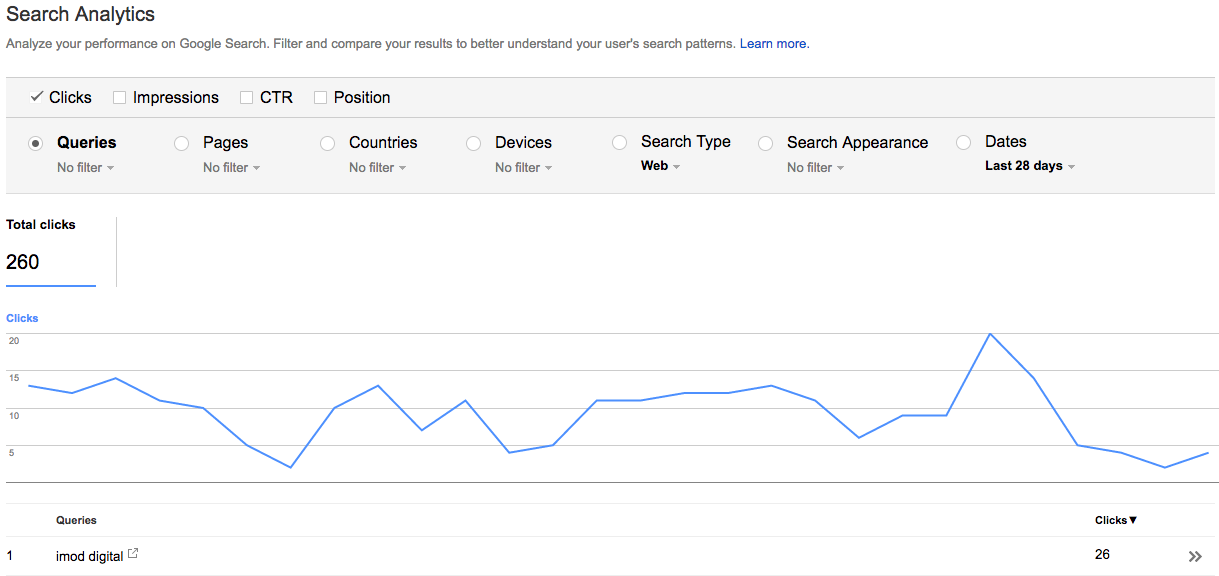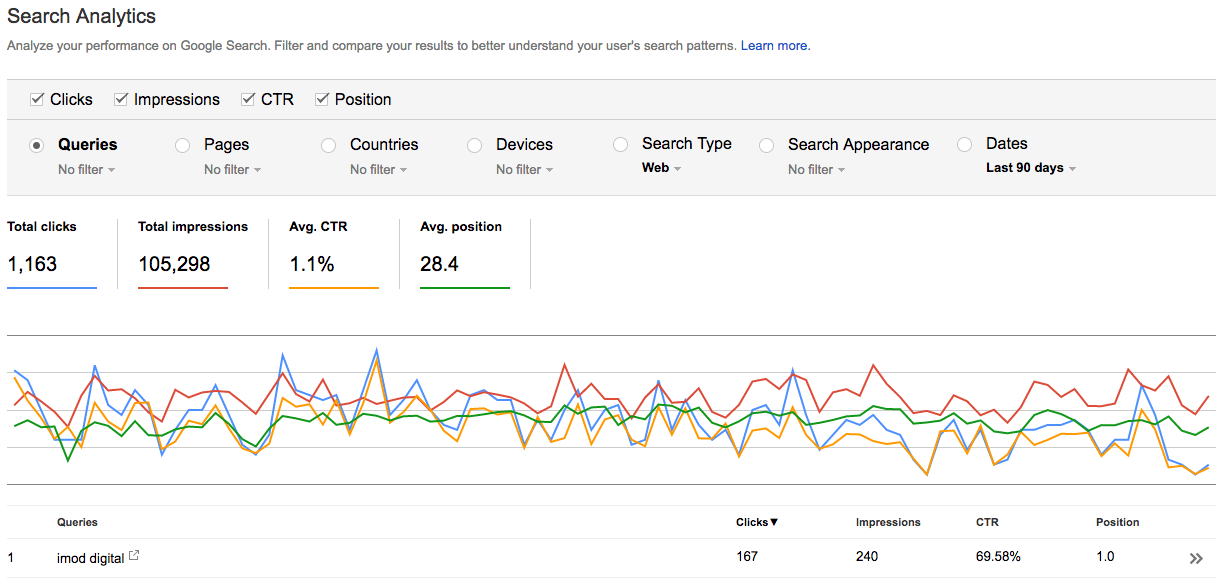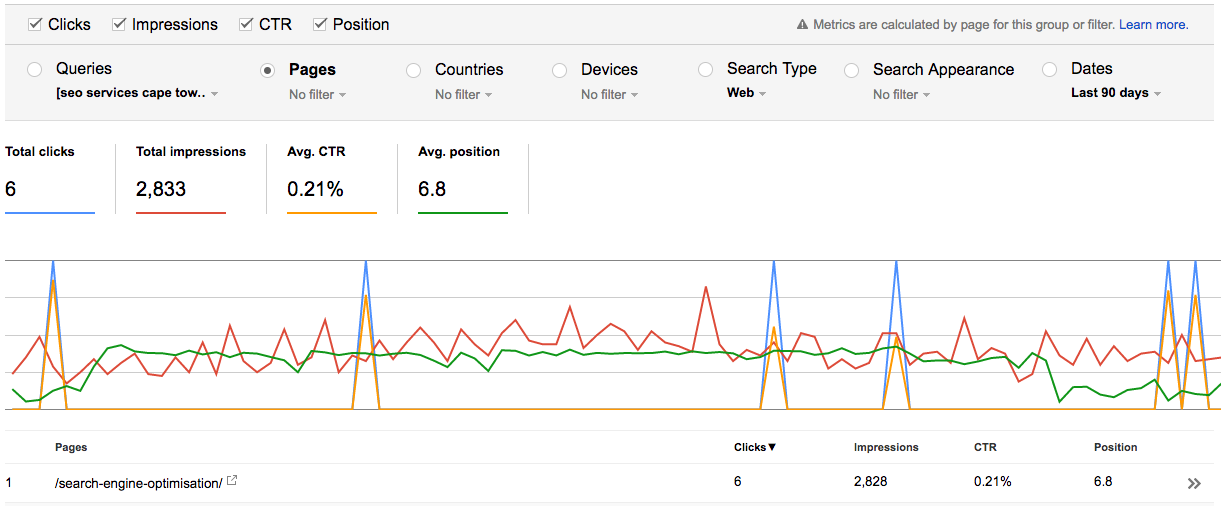Google’s Search Console (formerly known as Webmaster Tools) is a free tool that offers a great deal of insight into your website visitors, yet it’s incredibly underutilised compared to Google Analytics. These tools should always be used in conjunction with each other and today we’re going to show you how Search Console may be used to spot traffic opportunities.
If you’re not using Search Console, click here, create an account and get yourself setup. If you do have an account, let’s get started.
Getting Started
Open up your search console account and click on “Search Analytics” under “Search Traffic” on the left-hand side menu. At this point you’ll be looking at something along these lines:

The Configuration
- Ensure that the following are checked: Clicks, Impressions, CTR and Position.
- The Queries radio button is selected.
- The Dates are set to Last 90 days.
You’ll now be seeing something like this:

What Are We Seeing?
What you’re looking at is 90 days worth of data about people coming to your website. More specifically, we’re looking at the queries (searched keywords) that people searched for and clicked through to your website. On top of this, we’re able to see how many clicks, how many impressions, the click-through ratio (CTR) and the position. What we’re interested in though is the clicks, impressions and position.
The Process!
If there is a query that is receiving a large number of impressions/clicks and has a position of 3.x or higher, then this is something we need to look at. What this means is that you’ve got a keyword that is bringing people to your website, but it’s ranked in position 4 or lower on the search results page. If your website appeared higher in the search results for this page, you would definitely get more clicks and you could take a look at the impressions to see just how many more clicks you might get.
Our advice here is to look at a number of the keywords and look for the opportunity:
- Receiving clicks.
- Impression count is high compared to clicks.
- Position is 3.x or higher.
The other factor is the click-through ratio (CTR), this is the rate / percentage at which people who see your website click through to it. If you have a high CTR, it means that people are attracted to the way your website appears in the search results. If the CTR is low, this may mean that you need to work on your meta title or description to make it more enticing. Taking the 3 points above, if you match that scenario and your CTR is quite high, there is a lot of opportunity. On the other hand, if you find a situation where the above 3 points match, but the CTR is low, it’s a good idea to look at changing the meta title and description, giving the page some time and then reviewing in Search Console to see if the CTR has increased and then proceed accordingly.
An Example

In the image above, there are two isolated keywords:
- “imod digital” – This is our company’s name, so we should be positioned in position 1 as we are. As you’ll see, for a brand term, the CTR will be really high and most of the impressions would result in clicks through to our website. This is an example of a keyword that we wouldn’t need to touch at all.
- “seo services cape town” shows us that we are in position 6.8 (far down the search results page) with a CTR of 0.21% (terribly low) and we only received 6 clicks, yet there are 2,828 impressions available. This is a really great example where we would need to do the following:
- Optimise and make our meta title and description better more enticing.
- Increase the optimisation on our page to get a higher position.
In example 2, by doing the 2 recommendations above we could substantially increase the number of visitors coming to our website for a search query that could potentially result in more business.
Page Selection
The section above, we said, “increase the optimisation on our page”, but which page would we work on? Thanks to Search Console, you can follow these steps to know exactly which page would need attention:
- Click on the query, in our case “seo services cape town”.
- Click on the “Pages” radio button.
We are now presented with the following:

In the image above, you can see that the /search-engine-optimisation/ page on our website is the one that is ranking for “seo services cape town” and is, therefore, the page that we need to work on.
Going Bigger
Up until now, we’ve been looking at one single example and situation, but if you really want to affect the number of visitors to your website, you want to look at the data and make a number of changes. We would recommend selecting 10 pages / posts that fit the criteria above and then look at the following as tasks worth performing:
- Open up a Google search and search for the query you’ve selected. Look carefully at the other results that appear and objectively decide if your meta title and description are enticing or is there room for improvement to increase the CTR or keyword usage.
- If you are wanting to increase the position, that boils down to search engine optimisation, which is a whole topic in itself, but the quick things to do are: Check your H1 and H2 tags, update the content/text on the page to be more relevant and more useful, perhaps add more content of value. If it’s a blog post, after you’ve made the updates, update the publication date.
If you go through this process for 10 pages/posts on your website, there is an incredibly high chance that you will affect change and that you will increase the number of people finding your website. We have performed this exercise countless times and the success is clear.
